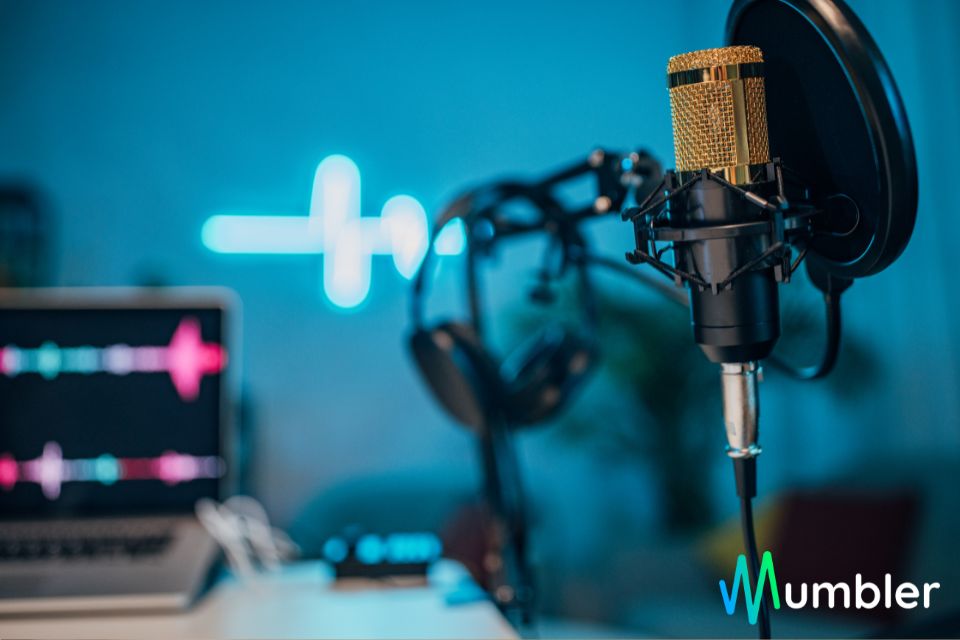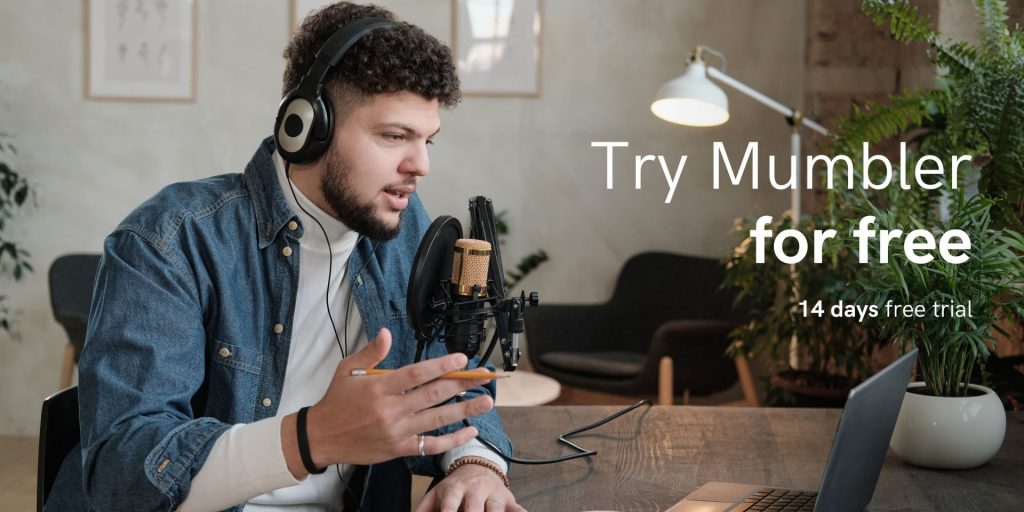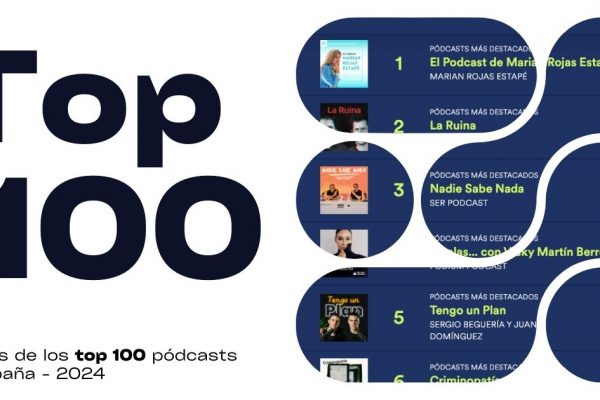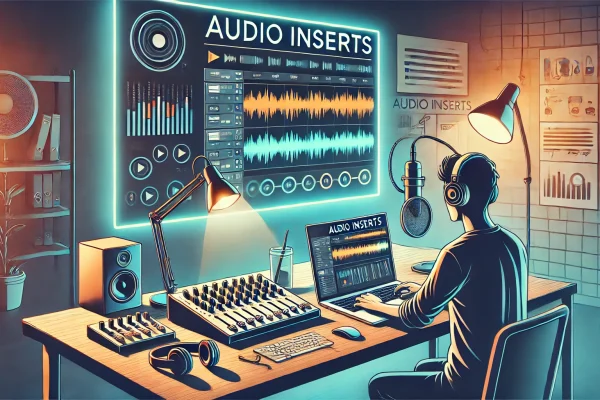Audiograms represent a powerful and versatile tool herramienta for promoting audio content across different digital platforms.
In a world where attention is a precious commodity and the competition to capture it is fierce, this type of content emerges as an indispensable ally for those looking to promote their podcast.
What makes them so relevant? The answer lies in their ability to blend the auditory with the visual in an attractive and captivating manner.
These dynamic clips take selected audio snippets and transform them into high-impact content, incorporating subtitles, animated soundwaves, and graphics that create an engaging multimedia experience.
Their significance lies in their ability to reach wider and more diverse audiences. .
Audiograms are ideal for individuals who don't have the time to create video content or visual clips.
Therefore, this format becomes an invaluable resource for content creators, especially for those aiming to maximize the visibility of their podcasts or audio materials in a saturated digital environment.
But before we proceed, let's understand what audiograms are and what purpose they serve.
What is an audiogram and what is it used for?
An audiogram is a multimedia file that combines audio snippets with visual elements such as animated soundwaves, subtitles, images, or graphics, representing and promoting audio content like podcasts, interviews, discussions, or recordings.
These dynamic and attractive clips effectively allow key sections of audio content to be shared on digital platforms, enhancing visibility and engagement with the audience on social media and other online mediums.
Audiograms are a valuable tool for condensing the essence of audio and capturing the attention of users who might not have otherwise engaged with the content.
How can you leverage audiograms to boost your content?
Let's explore that right now.
How can audiograms enhance a podcast's visibility and engagement?
Audiograms act as visual hooks, drawing potential listeners in environments where visual content has a significant impact, such as YouTube or social media platforms.
By making the audio visually appealing, podcasts stand out amid the online information flood, increasing the likelihood of being seen, heard, and shared.
These visual elements enable quick identification of the topic and content essence, piquing the viewer's curiosity and encouraging them to listen to the full audio.
Moreover, by including subtitles or transcriptions, audiograms become accessible to a broader audience , including those with hearing impairments or in situations where audio cannot be played.
However, the true significance of audiograms goes far beyond what we've just mentioned.

The importance of audiograms in podcast marketing
Audiograms have become fundamental pillars of podcast marketing due to their ability to transcend audio barriers and capture attention in online visual environments.
What is the role of audiograms in promoting content on visual platforms?
In a digital landscape inundated with visual information, audiograms represent an innovative strategy to showcase audio content in visual settings, such as social media.
Their ability to transform sound into visually appealing content gives them a significant advantage.
Imagine scrolling through your social media feed and encountering an audiogram with dynamic graphics, moving soundwaves, and eye-catching subtitles. These visual elements instantly grab users' attention in an increasingly visual-dominated environment.
The challenge for content creators lies in adapting to platforms designed for visual content, and this is where audiograms come into play.
These audio snippets transformed into visual images attract an audience that might otherwise overlook auditory content.
They allow podcasting, a primarily auditory format, to integrate and stand out in a digital world dominated by visuals.
Audiograms act as a bridge between audio content and visual platforms. By presenting compelling sound bites accompanied by stimulating visual elements, they succeed in capturing attention, generating interest, and increasing the likelihood that viewers engage with the podcast's complete content.
Their adaptability and versatility for sharing and consumption on platforms like Instagram, Twitter, Facebook, and others demonstrate their potential to amplify podcast visibility and reach wider and more diverse audiences..
Examples of how audiograms can capture attention on social media and other digital channels
As explained earlier, audiograms are a powerful tool in podcast promotion due to their ability to generate interaction and capture attention in visual environments.
Here are specific examples of how audiograms impact different digital platforms:
- Instagram: Audiograms can stand out through feed posts, stories, or reels. By leveraging visual elements like animated soundwaves, compelling subtitles, and attractive design, creators can visually share podcast snippets and draw users' attention while scrolling.
- Twitter: Audiograms can be shared as short videos to capture attention with dynamic soundwaves combined with subtitles highlighting relevant quotes or intriguing podcast moments. Additionally, background images can emphasize the episode's theme and complement the visual content.
- Facebook: Audiograms can be used in regular posts or paid ads. Engaging visual content, along with the platform's audio playback capability, can increase viewer engagement and interaction with your podcast.
- Short-form video platforms : On platforms like TikTok or YouTube Shorts, audiograms can be adapted to capture attention in short videos. These visual snippets can be shared with dynamic transitions, vibrant colors, and visual elements that highlight the podcast's essence.
In summary, audiograms have the ability to adapt to various digital platforms and leverage each platform's specific features. By creating engaging content, audiograms become valuable tools for promoting podcasts and amplifying their reach in an increasingly visually oriented digital environment.
Key elements of an effective audiogram
Audiograms are more than simple visual representations of audio and require a careful combination of elements to maximize their effectiveness in podcast promotion.
Let's explore the essential components for creating an effective audiogram:
- Audio: The choice of audio snippet is critical. It should be captivating, representative of the podcast content, and intriguing enough to engage the audience in a short period. This could be an exciting excerpt, a compelling statement, or relevant advice that maintains your message's essence.
- Transcription or subtitles: Including transcriptions or subtitles in the audiogram is crucial to enhance accessibility. Subtitles allow viewers to follow the content even if they can't listen to the audio at that moment. Additionally, they help capture the attention of viewers scrolling through their feed where audio is not enabled.
- Background images: Background images are used to complement the audio content. They can be photographs, illustrations, or graphics that reinforce the message conveyed by the audio. The proper selection of images can enhance understanding and the audiogram's visual impact.
- Soundwave animations: Moving soundwaves are a distinctive feature of audiograms. These visual animations represent audio as waves or bars that move in sync with the sound. They add dynamism to the audiogram and indicate associated audio content.
Together, these elements combine to create an audiogram that captures the viewer's attention and provides an engaging visual experience. Thoughtful selection and effective integration of these components are essential for creating audiograms that stand out and generate interaction in digital environments.
Tools and software for creating audiograms
Creating audiograms requires specialized tools that transform audio into attractive and shareable visual content.
Here is a comparative list of different tools and software available in the market and their respective features.
List and comparison of different tools and software available for creating audiograms
Several tools and software are designed for audiogram creation, each with its own characteristics and functionalities. Here's a comparative list of some of the most popular options:
- Headliner: This platform allows easy audiogram creation. It offers options to import audio, add images, subtitles, and create animated soundwaves. Headliner provides an intuitive interface and customization options.
- Wavve: Another powerful tool that facilitates audiogram creation. It allows audio importing, subtitle addition, image adjustments, and practical animation generation. Moreover, it offers straightforward sharing options on social media.
- Descript: Unlike other tools, Descript offers a unique functionality by allowing audio editing through transcription. Users can edit text to modify audio and then export snippets as audiograms. Ideal for those seeking advanced editing options.
- Adobe Premiere Pro/Audition: For users experienced in audio and video editing, Adobe offers advanced options. Premiere Pro and Audition enable audiogram creation with a high level of customization and control over design and sound.
- Canva: Although not designed specifically for audiograms, Canva is a versatile tool for creating customized images to accompany audio. It offers a wide range of templates and design options.
- Facebook Transcription Tool: The classic social network offers a tool that automatically converts audio into subtitles. While not a comprehensive audiogram creation tool, it can be useful for adding subtitles to videos shared on the platform.
Each of these tools has its own advantages and limitations in terms of functionalities, ease of use, customization options, and cost. Choosing the right tool will depend on the user's specific needs, technical skills, and desired features for creating high-quality audiograms.
Comparing and testing these options can help find the most suitable tool for the desired purpose.
Advantages, disadvantages, and unique features of each option
When evaluating tools for audiogram creation, it's essential to consider their strengths, limitations, and distinctive aspects to make the most informed decision:
Advantages and disadvantages of using Headliner
Advantages: Offers an easy-to-use interface, ideal for beginners. Provides customization options and attractive visual effects. Integrates features for creating animated soundwaves and subtitles.
Disadvantages: The free version has limitations in functionalities and adds watermarks to generated audiograms. Some advanced features may require a paid subscription.
Advantages and disadvantages of using Wavve
Advantages: User-friendly similar to Headliner, with customization options and attractive visual effects. Allows easy exporting and sharing on social media. Offers subscription options including more features.
Disadvantages: The free version has restrictions on functionalities and adds watermarks to generated files. Some advanced functions are available only in paid plans.
Advantages and disadvantages of using Descript
Advantages: Provides a unique audio editing functionality through transcription. Allows audio modification through text and exporting snippets as audiograms. Ideal for those seeking advanced editing options.
Disadvantages: May have a steeper learning curve for new users. Does not offer as many pre-designed visual options as other audiogram-specific tools.
Advantages and disadvantages of using Adobe Premiere Pro/Audition
Advantages: Professional audio and video editing tools with a wide range of options to customize audiograms. Offers detailed control over design and sound.
Disadvantages: Requires an advanced level of technical skills. It's a more complex and expensive option compared to specific audiogram tools.
Advantages and disadvantages of using Canva
Advantages: Offers a wide variety of templates and design options to create attractive images to accompany audio. It's easy to use and can be helpful for the visual part of audiograms.
Disadvantages: Not designed for creating audiograms, so its audio function is limited. It may not be as robust as other tools specialized in audio.
Advantages and disadvantages of using Facebook's transcription feature
Advantages: Automates the creation of subtitles from audio. It's a quick and easy option for adding subtitles to videos shared on the platform.
Disadvantages: Limited functionalities for creating audiograms. Doesn't offer as many customization options as tools dedicated to this purpose.
Each tool has its own set of features that align differently with users' needs and skills. Choosing the ideal tool will depend on preferences in interface, level of technical expertise, desired functionalities, and willingness to invest in paid options.
It's crucial to evaluate all these factors before selecting the most suitable tool for creating audiograms.

Step-by-step tutorial on how to create an audiogram
We've established the importance that an audiogram can have in our content strategy.
How about we see what the best way is to create one?
Detailed instructions on how to create an audiogram, from selecting the audio clip to exporting the final file
Creating an audiogram requires specific steps to ensure an attractive and effective result. Here is a step-by-step guide for you to do it too:
- Select the audio segment: Choose the episode segment that best represents the content or is most attractive to your audience. Ensure it's brief, clear, and captivating.
- Choose the right tool: Select the platform or software to create the audiogram. You can opt for any of the previously mentioned tools or any other that fits your needs and skills.
- Import the audio: Upload the selected audio snippet to the chosen tool. Usually, these platforms have options to import audio files from your device or cloud storage services.
- Add visual elements: Use background images related to the episode content to accompany the audio. Add subtitles that reflect the text of the audio snippet and adjust their style and location to make them legible.
- Generate animated sound waves: Many tools offer the option to create moving sound waves that visualize the audio. Adjust the settings to generate dynamic waves synchronized with the sound.
- Customize the design: Add your brand or visual identity if necessary. Adjust the design, colors, and effects to make the audiogram consistent with your brand image or podcast style.
- Review and edit: Listen to and view the complete audiogram to ensure clear audio, relevant images, and properly synchronized subtitles.
- Export the audiogram: Once you're satisfied with the result, export the final file in the appropriate format. Usually, these tools offer options to save the audiogram in different video or image formats.
- Share the audiogram: Share the audiogram on your social networks, website, or podcast platform. Take advantage of the publishing options offered by the tool to reach your audience.
This step-by-step guide will walk you through creating an audiogram from selecting the audio segment to publishing the final file. This way, the resulting content will be attractive, representative, and effective in promoting your podcast.
Tips for customizing the audiogram to make it more appealing to the audience
Customizing an audiogram is crucial to stand out in visual environments and capture the attention of the target audience.
Here are some guidelines you can follow to do it:
- Relevant images: Select background images or graphics related to the audio content. Use striking photographs, relevant illustrations, or graphics that complement the message.
- Consistent visual style: Maintain a consistent visual style in your audiograms to reinforce your brand identity or podcast theme. Use colors, fonts, and designs that align with the overall image of your content.
- Attractive subtitles: Subtitles should be readable and engaging. Choose clear fonts and an appropriate size to make them easy to read. Use contrasting colors or visual effects that highlight the subtitles in the audiogram.
- Dynamic animations: Take advantage of animation options offered by tools to create moving sound waves or visual effects that increase the audiogram's dynamism. This helps capture attention more effectively.
- Selection of engaging segments: Choose exciting, informative, or intriguing audio segments that catch the listener's attention. An impactful beginning can be crucial in maintaining interest and motivating listeners to hear the entire episode.
- Consistency in design: When creating a series of audiograms, ensure there's coherence in design, structure, and style. This creates recognition and familiarity among your followers.
- Call-to-action : Include a clear and direct call-to-action in the audiogram. You can invite the audience to listen to the full episode, subscribe to the podcast, or visit your website for more content.
- Testing and adjustments: Experiment with different visual styles, designs, and elements to see which ones generate more interaction and engagement with your audience. Adjust your strategy based on the results obtained.
By applying these tips and effectively customizing your audiograms, you'll increase the likelihood of capturing the audience's attention, successfully promoting your content, and motivating the audience to interact and actively engage with your podcast.
Recommendations on how to maximize the impact of audiograms
Maximizing the impact of audiograms requires strategy and creativity.
In this section, we will explore key recommendations and creative suggestions to make these visual elements stand out on different platforms and effectively integrate them into a podcast marketing strategy.
Here are some key recommendations for you:
- Content segmentation: Identify the most attractive, intriguing, or informative moments of your episodes. Highlight these segments in your audiograms to capture attention and generate interest in your audience.
- Frequency and consistency: Publish audiograms to maintain presence and interest in your podcast.
- Platform adaptation: Customize your audiograms according to the platform where you'll share them. Ensure they fit the format and expectations of each social network to maximize their effectiveness.
- Testing and analysis: Conduct A/B tests with different styles, formats, and durations of audiograms to understand what works best with your audience. Use metrics and analysis to evaluate the performance of your audiograms and adjust your strategy accordingly.
- Inclusion of calls to action: Add clear and relevant calls to action in your audiograms. Invite your audience to subscribe, share, comment, or visit your website to increase interaction.
- Collaborations and tagging: Collaborate with other content creators or guests from your podcast. Tag them in the audiograms involving them to increase reach through their audiences and social networks.
- Variety and creativity: Experiment with different styles, designs, and creative approaches in your audiograms. Variety can maintain your audience's interest and curiosity while attracting different user segments.
- Interactivity: Consider adding interactive elements to your audiograms, such as polls, questions, or challenges that encourage active audience participation.
- Mobile optimization: Ensure your audiograms are accessible and effective on mobile devices. This is crucial as the majority of content consumption occurs through mobile devices.
By implementing these recommendations, you'll be able to enhance the impact of your audiograms, increase your podcast's visibility, and improve interaction with your audience, which can lead to organic growth and greater follower loyalty.
Creative ideas to make audiograms stand out and adapt to different platforms.
To stand out on digital platforms and capture your audience's attention, it is essential to adapt audiograms in a creative and strategic ways.
Here are some innovative ideas:
- Reels and TikTok: Use short, dynamic clips tailored to Instagram's Reels or TikTok's short video format. Apply eye-catching visual effects, transitions, and concise yet impactful subtitles to grab attention.
- Instagram and Facebook Stories: Create audiograms that fit the vertical format of Stories. Use clear, large subtitles, attractive visuals, and surprising animations to encourage the audience to watch more.
- Mini tutorials or quick tips: Select audio snippets containing valuable information or useful advice. Create audiograms that present these tips attractively and share them as quick knowledge nuggets.
- Highlighted interviews: If your podcast features interviews with notable figures, use fragments of those conversations to generate interest. Add subtitles that highlight key points or intriguing moments to capture attention.
- Custom visual effects: Experiment with unique visual effects. Add creative text effects, transition animations, or graphics that reinforce the audio message and make your audiograms stand out.
- Audiogram series: Develop a series of themed or sequential audiograms to keep your audience engaged. Use a consistent visual design or style to identify the series and maintain interest in related episodes.
- Exclusive audiogram content: Offer exclusive content or episode previews through audiograms. This can incentivize your audience to follow your social media for access to this privileged content.
- Related GIFs and memes: Create relevant memes or gifs that reinforce the episode's message. This can increase virality and the potential for content sharing among the audience.
- Behind-the-Scenes Content: Share fun or interesting snippets from behind-the-scenes moments of the podcast. This adds a personal and human touch that can connect with your audience.
- Vissual collaborations : Collaborate with visual artists or designers to create audiograms that combine unique illustrations with audio snippets, adding aesthetic and creative value to the content.
By implementing these creative ideas and adapting your audiograms to different platforms with innovative approaches, you can captivate your audience, increase engagement, and set your content apart.
Integrating audiograms into your podcasting strategy:
As we've seen, audiograms are a fundamental tool to enhance your visibility and increase the plays of your audio content.
If we have to highlight the most important aspects, they would be as follows:
Summary of the benefits of using audiograms:
- Visual attraction: Audiograms capture attention in visual environments and expand the visibility of audio content on digital platforms.
- Increased engagement: They stimulate interaction and audience commitment by presenting content in an attractive and accessible manner.
- Audience expansion: The inclusion of subtitles or transcriptions allows reaching a more diverse audience, especially those with hearing disabilities.
Try them out and then let us know the results.
Final tips for integrating audiograms into your podcast marketing strategy
Remember to consider the following guidelines before starting:
- Consistent planning: Include audiogram creation as a regular part of your podcast marketing strategy.
- Monitoring and adjustment: Analyze performance metrics to understand which audiograms generate more interaction and adjust your approach accordingly.
- Continuous innovation: Stay updated on trends and new tools to enhance the quality and relevance of your audiograms.
If you integrate audiograms strategically and consistently into your overall podcast marketing strategy, you'll leverage the potential of all these tools to improve your reach and audience engagement.
Try different tools, alternate between various templates, measure the impact, and keep trying until you find the right style.
Now that you know how, are you up for it?
About the author
Content Manager at Mumbler.
Podcaster and content creator.
Passionate about communication and a fan of the WordPress community.
I talk about movies and series on Babel Infinito.
I talk about podcasting on Todo por Un Podcast.








